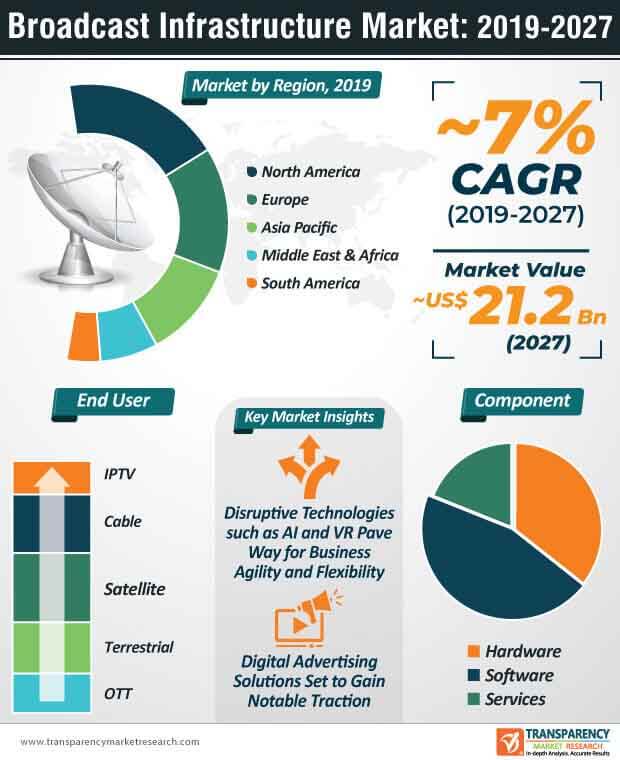
Broadcasters Seeking Cost-effective Delivery Models to Meet Varied Consumer Demand
Broadcast infrastructure is arguably one of the most essential aspects of on-air presentation, and at present, broadcasters are seeking cost-effective solutions to improve their efficiency and overall output. The significant rise in the popularity of over-the-top (OTT) video streaming services, along with ascending Internet penetration, worldwide, is likely to aid the growth of the broadcast infrastructure market in the near future. Owing to remarkable advancements in technology over the past decade, viewers seek the flexibility of viewing content from any location, on any device, and at any given time. Key participants in the market are thus focusing on providing high-quality content across various networks, including digital terrestrial television (DTT) and broadband.
Request a sample to get extensive insights into the Broadcast Infrastructure Market
In their quest toward attaining commercial flexibility and agility, market players are developing new solutions in conjunction with the existing ones. This approach has paved the way for infrastructure duplication, isolated systems, and various other operational characteristics. However, at the back of these developments, players in the broadcast infrastructure market have expressed that operational costs are on the rise, and a sustainable delivery model is the need of the hour.
TMR predicts that, the broadcast infrastructure market will grow at a decent CAGR of ~7% from 2019 to 2027, expanding 1.75X by the end of the said period.
Market Players Eye Potential of IP Technology to Address Content Delivery Barriers
The onset of fresh video formats has played a key role in improving the adoption of IP technology in the last few years. Established market participants are currently exploring the potential benefits of this technology to overcome the barriers put forward by existing content delivery models. The integration of IP technology will not only allow broadcasters to provide high-quality video formats but also assist them with remote production and content delivery. For instance, by adopting IP technology, broadcasters at Wimbledon could use any signal from any court without a different routing infrastructure. The adoption of IP technology within broadcast companies is expected to grow at the back of the entry of SMPTE 2110 into the market. SMPTE 2110 is a major step in moving broadcast production toward IP, and will enable broadcasters to adopt a flexible workflow, as they can efficiently differentiate audio, video, and ancillary data.
Industry experts are of the opinion that, the adoption of IP technology is one of the most disruptive trends within the broadcast infrastructure market sector. However, despite the numerous benefits of this technology, at present, only a few media companies are completely relying on IP, as the inclination toward selective dissemination of information (SDI) infrastructure still remains high. As broadcasters continue to recognize the potential of IP, significant uptake of this technology is expected in the next five years. With broadcast infrastructure swaying toward IP and cloud, media companies and broadcasters are expected to invest in cybersecurity to fend off hackers.

Digitization and Cloud Technologies – Future of Video Broadcasting
In the current day and age, video consumption patterns have witnessed a drastic change, worldwide. To stay relevant in the market, broadcast companies are gradually leaning away from conventional platforms and embracing cutting-edge solutions such as cloud technologies. At present, video on demand (VOD) is predominant in the broadcasting sphere – a trend that is expected to continue in the foreseeable future, as traditional TV viewing continues to take a hit. Steep pricing models, inconsistent broadcast schedules, and lack of flexibility in terms of access are some of the leading factors that have propelled the demand for online broadcasting. Further, conventional processes that are deployed to encode, capture, archive, and distribute video require very high investments in hardware equipment. Production teams are thus moving away from legacy broadcast hardware solutions toward agile and scalable software solutions in the cloud.
To understand how our report can bring difference to your business strategy, Ask for a brochure
These discrepancies in traditional video broadcasting have significantly increased the adoption of cloud-based video solutions that provide the desired levels of speed and flexibility to broadcasters. Industry-grade cloud solutions are designed to tackle redundancy, and broadcasters can deploy their custom-built broadcasting infrastructure across various data centers and regions. Cloud-based solutions enable broadcasters to integrate their services with various software as a service (SaaS) platforms. Owing to the benefits offered by cloud-based technologies, players operating in the broadcast infrastructure market are gradually moving away from conventional broadcasting infrastructure techniques.
Stuck in a neck-to-neck competition with other brands? Request a custom report on Broadcast Infrastructure Market
Broadcast Infrastructure Market in Brief
- The global broadcast infrastructure market is projected to expand at a CAGR of ~7% from 2019 and 2027. The global broadcast infrastructure market is estimated to be driven by increasing investments in IT infrastructure across end-user verticals such as OTT, terrestrial, satellite, cable, and IPTV.
- The global broadcast infrastructure market is expected to reach a value of ~US$ 2 Bn by 2027.
- North America holds a major share of the global broadcast infrastructure market. It is anticipated to dominate the global market during the forecast period, followed by Europe.
- North America also remains the leading market for broadcast infrastructure, globally, with the market estimated to be valued at ~US$ 4.3 Bn by the end of 2019.
- The broadcast infrastructure market in the Middle East & Africa is anticipated to expand at a moderate pace during the forecast period.
- The broadcast infrastructure market in Asia Pacific is projected to expand at a notable CAGR of ~7% during the forecast period.
Broadcast Infrastructure Market – Definition
- The broadcast infrastructure market report provides analysis of the global broadcast infrastructure market for the period 2017–2027, wherein, 2018 is the base year and 2019 to 2027 is the forecast period. Data for 2017 has been included as historical information.
- The study on the broadcast infrastructure market would help clients understand the analysis of broadcast infrastructure among different technologies.
- Broadcast infrastructure streamlines workflow to improve on-air presentation. The demand for broadcast infrastructure is expected to be driven by the increased need for efficient operations at lesser cost.
- Cisco states that, dramatic increase in the demand for broadcast solutions will not only be driven by the increased popularity of OTT video streaming services, but also by the number of people that are expected to be connected by 2019. Over half the planet (around 3.9 billion people) are likely to have access to the Internet by that time, but the number of devices able to access the web will be three times as high as the global population.
North America Broadcast Infrastructure Market – Snapshot
- North America is seen as the growth hub for new technology-driven enterprise business models, for its start-up ecosystem and quick adoption of technology solutions by enterprises in the region.
- For the same reason, North America is expected to see the highest opportunity addition for the broadcast and media technology (solutions and services) market, globally, with Asia Pacific being the next closest region.
Key Drivers of Global Broadcast Infrastructure Market
Growing demand for emerging technologies among broadcast and media companies
- Broadcast infrastructure companies are implementing advanced technology such as Artificial Intelligence, Augmented & Virtual Reality, Blockchain, Chatbot’s, Digital assistants, and 4DX. Broadcast infrastructure companies are adopting advanced technology to increase business agility and flexibility.
- Emerging technology enables companies to improve user experience. For instance, in China and the U.S., large companies such as Baidu, Tencent, and Netflix have implemented emerging technology to improve user experience. Further, Artificial Intelligence (AI) has a major impact on the streaming viewer’s experience.
- Netflix implemented AI technology to suggest content based on viewing preferences, and it also helps optimize video compression and delivery. The adoption of AI technology provides opportunity to automate workflows. Netflix claims that the deployment of AI technology has led to savings of around US$ 1 Bn a year.
- The growing adoption of online multimedia content is also one the major reasons driving the demand for video servers, which indirectly influences the growth of the broadcast infrastructure market. Consumers are emphasizing on live video services with high-speed network access and multiple connected devices such as tablets and smartphones. For instance, Hotstar is one of the biggest live streaming platforms in India, and has around 60 million viewers.
- Broadcasters manipulate, ingest, and play out large amounts of content in many different formats. The main concern of broadcasters is that, the content should be instantly accessible, must be securely stored, and easily repurposed for various media outlets.
- Further, rapid rise in unstructured broadcasting content or data and the explosion of unstructured data are demanding new methodologies and storage capabilities for enterprises.
- Hence, rise in the collection of unstructured data by broadcast & media companies is expected to boost the broadcast infrastructure market.
Broadcast Infrastructure Market – Company Profiles Snapshot
- Grass Valley USA, LLC (Belden Inc.)
Grass Valley USA, LLC, a Belden brand, is a key player operating in the field of content & media technology. It provides broadcast solutions to broadcast and media companies. Grass Valley offers training, installation, and development services for customized software as well as aftersales services. The company serves broadcasters as well as IPTV, cable, and satellite operators. It offers media playout and automation products, which allows television broadcasters to manage the playout of live, pre-recorded, and graphic content to air. It also provides monitoring and control products to manage several broadcast signals across the globe
- Cisco Systems, Inc.
Cisco Systems, Inc. manufactures, designs, and sells Internet Protocol (IP) and other products related to the information technology (IT) industry and communications. Cisco offers software, hardware, and services that are used to build Internet solutions, which makes networks possible for broadcast infrastructure organizations. The company also offers media, broadcast, and content within the service provider market. Cisco provides its services and products directly through its own sales force and channel partners to consumers, large enterprises, service providers, and for commercial businesses.
- Ericsson AB
Ericsson Inc. provides network and communication equipment, services, and software, for business and network operations. It is one of the leading providers of information and communication technology, with around 40% of the world’s mobile traffic carried over Ericsson networks. The company was established in 1984, and operates as a subsidiary of Telefonaktiebolaget LM Ericsson. It offers solutions such as 5G access, cellular IoT, and network intelligence for the media industry, telecom operators, transport sector, and utilities across the globe.
- Other major players operating in the global broadcast infrastructure market and profiled in the report include
- Acorde Technologies S.A
- AVL Technologies, Inc.
- Clyde Broadcast Technology Ltd
- Eletec Broadcast Telecom S.A.R.L
- EVS Broadcast Equipment SA
- Kaltura Inc.
- Zixi, LLC.
Read Our Latest Press Release:
About Us
Transparency Market Research is a next-generation market intelligence provider, offering fact-based solutions to business leaders, consultants, and strategy professionals.
Our reports are single-point solutions for businesses to grow, evolve, and mature. Our real-time data collection methods along with ability to track more than one million high growth niche products are aligned with your aims. The detailed and proprietary statistical models used by our analysts offer insights for making right decision in the shortest span of time. For organizations that require specific but comprehensive information we offer customized solutions through ad-hoc reports. These requests are delivered with the perfect combination of right sense of fact-oriented problem solving methodologies and leveraging existing data repositories.
Contact
Transparency Market Research State Tower,
90 State Street,
Suite 700,
Albany NY – 12207
United States
USA – Canada Toll Free: 866-552-3453





